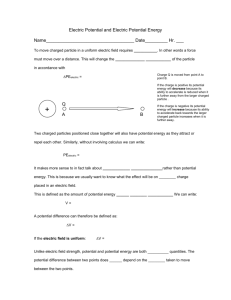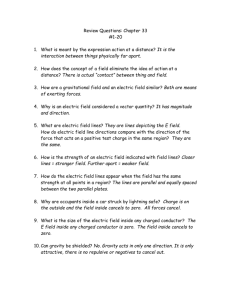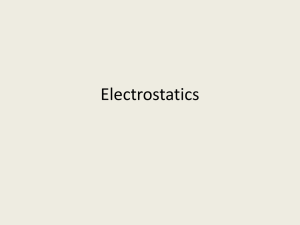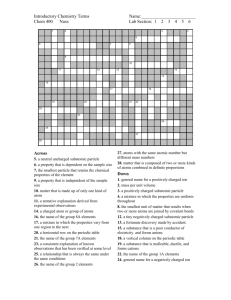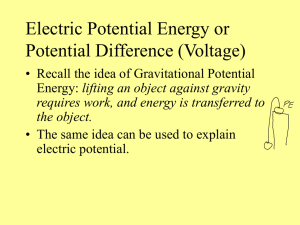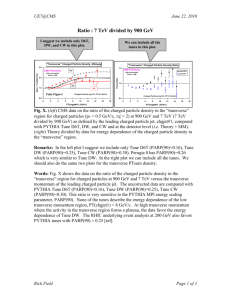Northwest Terascale Workshop at the University of Florida
advertisement
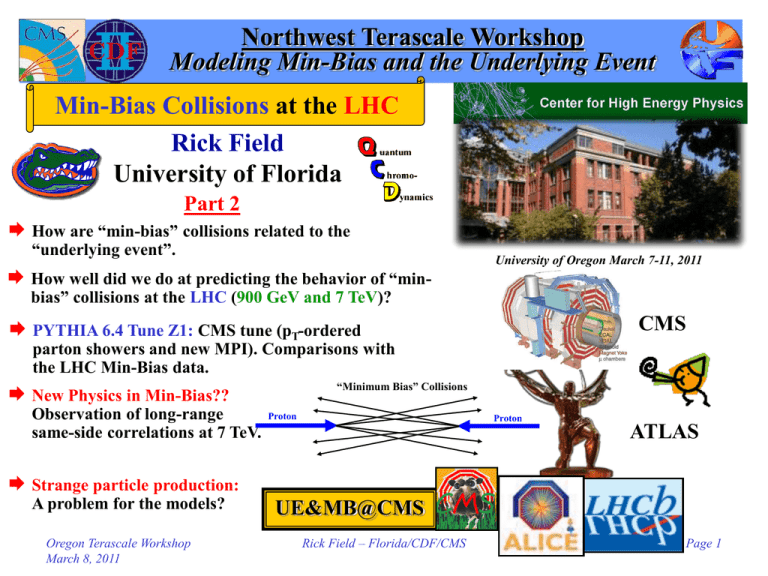
Northwest Terascale Workshop Modeling Min-Bias and the Underlying Event Min-Bias Collisions at the LHC Rick Field University of Florida Part 2 How are “min-bias” collisions related to the “underlying event”. How well did we do at predicting the behavior of “min- University of Oregon March 7-11, 2011 bias” collisions at the LHC (900 GeV and 7 TeV)? CMS PYTHIA 6.4 Tune Z1: CMS tune (pT-ordered parton showers and new MPI). Comparisons with the LHC Min-Bias data. “Minimum Bias” Collisions New Physics in Min-Bias?? Observation of long-range same-side correlations at 7 TeV. Proton Proton ATLAS Strange particle production: A problem for the models? Oregon Terascale Workshop March 8, 2011 UE&MB@CMS Rick Field – Florida/CDF/CMS Page 1 Proton-Proton Collisions Elastic Scattering Single Diffraction Double Diffraction M2 M M1 stot = sEL + sSD IN +sDD +sHC ND “Inelastic Non-Diffractive Component” Hard Core The “hard core” component contains both “hard” and “soft” collisions. “Hard” Hard Core (hard scattering) Outgoing Parton “Soft” Hard Core (no hard scattering) Proton PT(hard) Proton Proton Proton Underlying Event Underlying Event Initial-State Radiation Final-State Radiation Outgoing Parton Oregon Terascale Workshop March 8, 2011 Rick Field – Florida/CDF/CMS Page 2 The Inelastic Non-Diffractive Cross-Section Occasionally one of the parton-parton collisions is hard (pT > ≈2 GeV/c) Proton Proton Majority of “minbias” events! Proton “Semi-hard” partonparton collision (pT < ≈2 GeV/c) Proton + Proton + Proton Proton Proton + Proton Proton +… Oregon Terascale Workshop March 8, 2011 Rick Field – Florida/CDF/CMS Multiple-parton interactions (MPI)! Page 3 The “Underlying Event” Select inelastic non-diffractive events that contain a hard scattering Proton Hard parton-parton collisions is hard (pT > ≈2 GeV/c) Proton 1/(pT)4→ 1/(pT2+pT02)2 The “underlying-event” (UE)! Proton Given that you have one hard scattering it is more probable to have MPI! Hence, the UE has more activity than “min-bias”. Oregon Terascale Workshop March 8, 2011 Proton + + Proton Proton Rick Field – Florida/CDF/CMS “Semi-hard” partonparton collision (pT < ≈2 GeV/c) Proton Proton +… Multiple-parton interactions (MPI)! Page 4 Allow leading hard scattering to go to zero pT with same cut-off as the MPI! Model of sND Proton Proton Proton Proton Proton + Proton “Semi-hard” partonparton collision (pT < ≈2 GeV/c) 1/(pT)4→ 1/(pT2+pT02)2 Model of the inelastic nondiffractive cross section! + Proton Proton Proton + Proton Proton +… Oregon Terascale Workshop March 8, 2011 Rick Field – Florida/CDF/CMS Multiple-parton interactions (MPI)! Page 5 UE Tunes Allow primary hard-scattering to go to pT = 0 with same cut-off! “Underlying Event” Fit the “underlying event” in a hard scattering process. Proton Proton All of Rick’s tunes (except X2): 1/(pT)4→ 1/(pT2+pT02)2 A, AW, AWT,DW, DWT, D6, D6T, CW, X1, “Min-Bias” “Min-Bias” (add (ND)single & double diffraction) and Tune Z1, are UE tunes! Proton Predict MB (ND)! Proton + + Proton Proton Proton Single Diffraction Predict MB (IN)! Oregon Terascale Workshop March 8, 2011 +… Proton + Proton Proton Double Diffraction M2 M Rick Field – Florida/CDF/CMS M1 Page 6 Charged Particle Multiplicity Charged Multiplicity Distribution Charged Multiplicity Distribution 1.0E+00 1.0E+00 CDF Run 2 Preliminary 1.0E-01 CDF Run 2 <Nchg>=4.5 CDF Run 2 <Nchg>=4.5 1.0E-02 Probability Probability 1.0E-02 CDF Run 2 Preliminary 1.0E-01 1.0E-03 1.0E-04 1.0E-05 py Tune A <Nchg> = 4.3 pyAnoMPI <Nchg> = 2.6 1.0E-03 1.0E-04 1.0E-05 1.0E-06 1.0E-06 Min-Bias 1.96 1.0E-07 Min-Bias 1.96 1.0E-07 Charged Particles (|h|<1.0, PT>0.4 GeV/c) Normalized to 1 Normalized to 1 Charged Particles (|h|<1.0, PT>0.4 GeV/c) 1.0E-08 1.0E-08 0 5 10 15 20 25 30 35 40 45 50 55 0 5 10 Number of Charged Particles i 20 25 30 35 40 45 50 Number of Charged Particles “Minimum Bias” Collisions Proton 15 No MPI! Tune A! AntiProton Data at 1.96 TeV on the charged particle multiplicity (pT > 0.4 GeV/c, |h| < 1) for “min-bias” collisions at CDF Run 2 (non-diffractive cross-section). The data are compared with PYTHIA Tune A and Tune A without multiple parton interactions (pyAnoMPI). Oregon Terascale Workshop March 8, 2011 Rick Field – Florida/CDF/CMS Page 7 55 PYTHIA Tune A Min-Bias “Soft” + ”Hard” Charged Particle Density 1.0E+00 Pythia 6.206 Set A CDF Min-Bias Data Charged Density dN/dhdfdPT (1/GeV/c) 1.0E-01 Ten decades! 1.8 TeV |h|<1 1.0E-02 12% of “Min-Bias” events have PT(hard) > 5 GeV/c! PT(hard) > 0 GeV/c 1.0E-03 1% of “Min-Bias” events have PT(hard) > 10 GeV/c! 1.0E-04 1.0E-05 CDF Preliminary 1.0E-06 0 2 4 6 8 PT(charged) (GeV/c) 10 12 14 Lots of “hard” scattering in “Min-Bias” at the Tevatron! Comparison of PYTHIA Tune A with the pT distribution of charged particles for “min-bias” collisions at CDF Run 1 (non-diffractive cross-section). pT = 50 GeV/c! PYTHIA Tune A predicts that 12% of all “Min-Bias” events are a result of a hard 2-to-2 parton-parton scattering with PT(hard) > 5 GeV/c (1% with PT(hard) > 10 GeV/c)! Oregon Terascale Workshop March 8, 2011 Rick Field – Florida/CDF/CMS Page 8 CDF: Charged pT Distribution Erratum November 18, 2010 Excess No excess events atat large large pTp! T! “Minimum Bias” Collisions Proton AntiProton 50 GeV/c! Published CDF data on the pT distribution of charged particles in Min-Bias collisions (ND) at 1.96 TeV compared with PYTHIA Tune A. Oregon Terascale Workshop March 8, 2011 CDF CDFinconsistent consistent with withCMS CMSand andUA1! UA1! Rick Field – Florida/CDF/CMS Page 9 MB Tunes “Underlying Event” Predict the “underlying event” in a hard scattering process! Proton Proton Most of Peter Skand’s tunes: S320 Perugia 0, S325 Perugia X, “Min-Bias” (ND) S326 Perugia 6 are MB tunes! Proton Fit MB (ND). Proton + Proton + Proton Proton Proton + Proton Proton +… Oregon Terascale Workshop March 8, 2011 Rick Field – Florida/CDF/CMS Page 10 MB+UE Tunes “Underlying Event” Fit the “underlying event” in a hard scattering process! Proton Proton Most of Hendrik’s “Professor” tunes: ProQ20, P329 are MB+UE! Simultaneous fit to both MB & UE “Min-Bias” (ND) Proton Fit MB (ND). Proton + Proton +… Oregon Terascale Workshop March 8, 2011 + Proton Proton Proton + Proton Proton The ATLAS AMBT1 Tune is an MB+UE tune, but because they include in the fit the ATLAS UE data with PTmax > 10 GeV/c (big errors) the LHC UE data does not have much pull (hence mostly an MB tune!). Rick Field – Florida/CDF/CMS Page 11 LHC MB Predictions: 900 GeV Charged Particle Density: dN/dh Charged Particle Density: dN/dh 5 5 RDF Preliminary Charged Particle Density Charged Particle Density RDF Preliminary 4 3 2 ALICE INEL Off by 11%! UA5 INEL INEL = HC+DD+SD 900 GeV 1 5 -1.5 -1.0 -0.5 0.0 4 Charged Particle Density -2.0 2 UA5 ALICE 1 pyDW_10mm (3.04) pyS320_10mm (3.09) pyS320 INEL (2.70) 0 -2.5 3 NSD = HC+DD Charged Particle Density: dN/dh 900 GeV pyDW INEL (2.67) Charged Particles (all pT) -3.0 4 RDF Preliminary 0.5 1.0 1.5 0 2.0 2.5 3.0 -3.0 -2.5 -2.0 times -1.5 1.11 -1.0 3 0.5 1.0 1.5 2.0 2.5 “Minimum Bias” Collisions “Minimum Bias” Collisions 2 Proton 1 0.0 PseudoRapidity h PseudoRapidity h Proton -0.5 INEL = HC+DD+SD 900 GeV Charged Particles (all pT) Proton ALICE INEL UA5 INEL pyDW times 1.11 (2.97) pyS320 times 1.11 (3.00) Proton 0 -3.0 ALICE -2.5 -2.0 -1.5 -1.0 with -0.5 0.0 0.5 1.0 1.5 2.0 DW 2.5 3.0and Tune S320 Compares the 900 GeV data PYTHIA Tune PseudoRapidity h Perugia 0. Tune DW uses the old Q2-ordered parton shower and the old MPI model. Tune S320 uses the new pT-ordered parton shower and the new MPI model. The numbers in parentheses are the average value of dN/dh for the region |h| < 0.6. Oregon Terascale Workshop March 8, 2011 Rick Field – Florida/CDF/CMS Page 12 3.0 ATLAS INEL dN/dh None of the tunes fit the ATLAS INEL dN/dh data with PT > 100 MeV! They all predict too few particles. Off by 20-50%! The ATLAS Tune AMBT1 was designed to fit the inelastic data for Nchg ≥ 6 with pT > 0.5 GeV/c! Oregon Terascale Workshop March 8, 2011 Soft particles! Rick Field – Florida/CDF/CMS Page 13 PYTHIA Tune DW If one increases the pT the agreement improves! Charged Particle Density: dN/dh 5 Charged Particle Density RDF Preliminary 4 At Least 1 Charged Particle |h| < 0.8 900 GeV ALICE INEL data pyDW generator level pT > 0.15 GeV/c Tune DW 3 pT > 0.5 GeV/c 2 pT > 1.0 GeV/c 1 0 -2.0 -1.5 -1.0 -0.5 0.0 0.5 1.0 1.5 2.0 PseudoRapidity h ALICE inelastic data at 900 GeV on the dN/dh distribution for charged particles (pT > PTmin) for events with at least one charged particle with pT > PTmin and |h| < 0.8 for PTmin = 0.15 GeV/c, 0.5 GeV/c, and 1.0 GeV/c compared with PYTHIA Tune DW at the generator level. “Minimum Bias” Collisions ProtonThe same thing occurs at 7 TeV! Proton ALICE, ATLAS, and CMS data coming soon. Oregon Terascale Workshop March 8, 2011 Rick Field – Florida/CDF/CMS Page 14 PYTHIA Tune DW Diffraction contributes less at harder scales! Charged Particle Density: dN/dh 5 Charged Particle Density RDF Preliminary 4 At Least 1 Charged Particle |h| < 0.8 900 GeV ALICE INEL data pyDW generator level pT > 0.15 GeV/c 3 Tune DW pT > 0.5 GeV/c 2 pT > 1.0 GeV/c 1 dashed = ND solid = INEL 0 -2.0 -1.5 -1.0 -0.5 0.0 0.5 1.0 1.5 2.0 PseudoRapidity h ALICE inelastic data at 900 GeV on the dN/dh distribution for charged particles (pT > PTmin) for events with at least one charged particle with pT > PTmin and |h| < 0.8 for PTmin = 0.15 GeV/c, 0.5 GeV/c, and 1.0 GeV/c compared with PYTHIA Tune Z1 at the generator level (dashed = ND, solid = INEL). “Minimum Bias” Collisions Proton Cannot trust PYTHIA 6.2 modeling of diffraction! Proton Oregon Terascale Workshop March 8, 2011 Rick Field – Florida/CDF/CMS Page 15 CMS dN/dh Charged Particle Density: dN/dh 8 CMS Charged Particle Density 7 TeV 6 4 RDF Preliminary CMS NSD data pyDW generator level Tune DW Soft particles! Okay if the Monte-Carlo does not fit dashedthe = ND solid = NSD data what do we do? All pT 0 We tune the Monte-Carlo -3.0 -2.5 -2.0 -1.5 -1.0 -0.5 0.0 0.5 1.0 1.5 2.0 2.5 3.0 to fit the data! PseudoRapidity h Be careful not to tune away new physics! Generator level dN/dh (all pT). Shows the NSD = HC + DD and the HC = ND contributions for Tune DW. Also shows the CMS NSD data. 2 “Minimum Bias” Collisions Proton Oregon Terascale Workshop March 8, 2011 Off by 50%! Rick Field – Florida/CDF/CMS Proton Page 16 CMS dN/dh Charged Particle Density: dN/dh Charged Particle Density: dN/dh 8 RDF Preliminary RDF Preliminary Charged Particle Density Charged Particle Density 8 6 Tune Z1 4 CMS 2 CMS NSD 7 TeV 7 TeV pyZ1 HC (6.51) pyZ1 NSD (5.58) 0 -3.0 -2.5 -2.0 -1.5 -1.0 -0.5 0.0 0.5 1.0 1.5 2.0 2.5 3.0 6 4 CMS 2 CMS NSD 7 TeV 7 TeV pyX2 NSD (5.91) pyZ1 NSD (5.58) CMS NSD all pT 0 -3.0 -2.5 -2.0 PseudoRapidity h -1.5 -1.0 -0.5 0.0 0.5 1.0 1.5 2.0 2.5 PseudoRapidity h Generator level dN/dh (all pT). Shows the NSD = HC + DD and the HC = ND contributions for Tune Z1. Also shows the CMS NSD data. Generator level dN/dh (all pT). Shows the NSD = HC + DD prediction for Tune Z1 and Tune X2. Also shows the CMS NSD data. “Minimum Bias” Collisions Okay not perfect, but remember Proton we do not know if the DD is correct! Proton Oregon Terascale Workshop March 8, 2011 3.0 Rick Field – Florida/CDF/CMS Page 17 PYTHIA Tune Z1 Charged Particle Density: dN/dh 5 Charged Particle Density RDF Preliminary 4 ALICE INEL data pyZ1 generator level At Least 1 Charged Particle |h| < 0.8 900 GeV pT > 0.15 GeV/c 3 pT > 0.5 GeV/c 2 pT > 1.0 GeV/c 1 0 -2.0 -1.5 -1.0 -0.5 0.0 0.5 1.0 1.5 2.0 PseudoRapidity h ALICE inelastic data at 900 GeV on the dN/dh distribution for charged particles (pT > PTmin) for events with at least one charged particle with pT > PTmin and |h| < 0.8 for PTmin = 0.15 GeV/c, 0.5 GeV/c, and 1.0 GeV/c compared with PYTHIA Tune Z1 at the generator level. “Minumum Bias” Collisions Okay not perfect, but remember Proton Proton we do not know if the SD & DD are correct! Oregon Terascale Workshop March 8, 2011 Rick Field – Florida/CDF/CMS Page 18 7 TeV dN/dh Min-Bias Common Charged PlotsParticle Density Ratio: dN/dh Charged Particle Density: dN/dh 4 1.20 7 TeV At Least 1 Charged Particle |h| < 0.8 CMS INEL data pyZ1 generator level pT > 0.5 GeV/c 3 2 1 At Least 1 Charged Particle |h| < 0.8 Corrected INEL data 1.10 pT > 0.5 GeV/c 1.05 1.00 0.95 0.90 7 TeV 0.85 CMS = solid squares ATLAS = solid circle -2.5 MB&UE Preliminary 1.15 Charged Particle Ratio Charged Particle Density MB&UE Preliminary CMS divided by ATLAS (red) 0.80 -2.0 -1.5 -1.0 -0.5 0.0 0.5 1.0 1.5 2.0 2.5 -2.5 -2.0 PseudoRapidity h -1.5 -1.0 -0.5 0.0 0.5 1.0 1.5 2.0 2.5 PseudoRapidity h Corrected data from CMS and ATLAS at 7 TeV for dN/dh (pT > PTmin, direct charged particles including leptons with no corrections for SD or DD) with at least one charged particle with pT > PTmin and |h| < 0.8 for PTmin = 0.5 GeV/c compared with PYTHIA Tune Z1. Ratio of the corrected data from CMS and ATLAS at 7 TeV for dN/dh (pT > PTmin) with at least one charged particle with pT > PTmin and |h| < 0.8 for PTmin = 0.5 GeV/c. CMS divided by ATLAS. Oregon Terascale Workshop March 8, 2011 Rick Field – Florida/CDF/CMS Page 19 7 TeV dN/dh Min-Bias Common Charged PlotsParticle Density Ratio: dN/dh Charged Particle Density: dN/dh 1.20 3 7 TeV At Least 1 Charged Particle |h| < 0.8 CMS INEL data pyZ1 generator level MB&UE Preliminary 1.15 Charged Particle Ratio Charged Particle Density MB&UE Preliminary pT > 1.0 GeV/c 2 1 1.10 pT > 1.0 GeV/c 1.05 1.00 0.95 0.90 7 TeV 0.85 CMS = solid squares ATLAS = solid circle At Least 1 Charged Particle |h| < 0.8 Corrected INEL data CMS divided by ATLAS (red) 0.80 0 -2.5 -2.0 -1.5 -1.0 -0.5 0.0 0.5 1.0 1.5 2.0 2.5 -2.5 -2.0 -1.5 -1.0 -0.5 0.0 0.5 1.0 1.5 2.0 2.5 PseudoRapidity h PseudoRapidity h Corrected data from CMS and ATLAS at 7 TeV for dN/dh (pT > PTmin, direct charged particles including leptons with no corrections for SD or DD) with at least one charged particle with pT > PTmin and |h| < 0.8 for PTmin = 1.0 GeV/c compared with PYTHIA Tune Z1 Ratio of the corrected data from CMS and ATLAS at 7 TeV for dN/dh (pT > PTmin) with at least one charged particle with pT > PTmin and |h| < 0.8 for PTmin = 1.0 GeV/c. CMS divided by ATLAS. Oregon Terascale Workshop March 8, 2011 Rick Field – Florida/CDF/CMS Page 20 900 GeV dN/dh Min-Bias Common Charged PlotsParticle Density Ratio: dN/dh Charged Particle Density: dN/dh 1.20 MB&UE Preliminary At Least 1 Charged Particle |h| < 0.8 1.8 pT > 0.5 GeV/c 1.6 1.4 1.2 900 GeV CMS = solid squares ALICE = open squares ATLAS = solid circle At Least 1 Charged Particle |h| < 0.8 Corrected INEL data 1.10 pT > 0.5 GeV/c 1.05 1.00 0.95 0.90 CMS divided by ALICE (blue) 900 GeV 0.85 1.0 -2.5 MB&UE Preliminary 1.15 Corrected INEL data pyZ1 generator level Charged Particle Ratio Charged Particle Density 2.0 CMS divided by ATLAS (red) 0.80 -2.0 -1.5 -1.0 -0.5 0.0 0.5 1.0 1.5 2.0 2.5 -2.5 -2.0 PseudoRapidity h -1.5 -1.0 -0.5 0.0 0.5 1.0 1.5 2.0 2.5 PseudoRapidity h Corrected data from CMS, ATLAS, and ALICE at 900 GeV for dN/dh (pT > PTmin, direct charged particles including leptons with no corrections for SD or DD) with at least one charged particle with pT > PTmin and |h| < 0.8 for PTmin = 0.5 GeV/c compared with PYTHIA Tune Z1 Ratio of the corrected data from CMS, ATLAS, and ALICE at 900 GeV for dN/dh (pT > PTmin) with at least one charged particle with pT > PTmin and |h| < 0.8 for PTmin = 0.5 GeV/c. CMS divided by ATLAS and CMS divided by ALICE. Oregon Terascale Workshop March 8, 2011 Rick Field – Florida/CDF/CMS Page 21 900 GeV dN/dh Min-Bias Common Charged PlotsParticle Density Ratio: dN/dh Charged Particle Density: dN/dh 1.20 MB&UE Preliminary 1.0 Corrected INEL data pyZ1 generator level Charged Particle Density Charged Particle Density 1.2 pT > 1.0 GeV/c 0.8 0.6 0.4 900 GeV At Least 1 Charged Particle |h| < 0.8 1.15 MB&UE Preliminary At Least 1 Charged Particle |h| < 0.8 Corrected INEL data 1.10 pT > 1.0 GeV/c 1.05 1.00 0.95 0.90 CMS divided by ALICE (blue) 900 GeV 0.85 CMS divided by ATLAS (red) CMS = solid squares ALICE = open squares ATLAS = solid circle 0.80 0.2 -2.5 -2.0 -1.5 -1.0 -0.5 0.0 0.5 1.0 1.5 2.0 2.5 -2.5 -2.0 -1.5 -1.0 -0.5 0.0 0.5 1.0 1.5 2.0 2.5 PseudoRapidity h PseudoRapidity h Corrected data from CMS, ATLAS, and ALICE at 900 GeV for dN/dh (pT > PTmin, direct charged particles including leptons with no corrections for SD or DD) with at least one charged particle with pT > PTmin and |h| < 0.8 for PTmin = 1.0 GeV/c compared with PYTHIA Tune Z1 Ratio of the corrected data from CMS, ATLAS, and ALICE at 900 GeV for dN/dh (pT > PTmin) with at least one charged particle with pT > PTmin and |h| < 0.8 for PTmin = 1.0 GeV/c. CMS divided by ATLAS and CMS divided by ALICE. Oregon Terascale Workshop March 8, 2011 Rick Field – Florida/CDF/CMS Page 22 dN/dh |h| < 2.4 (2.5) Charged Particle Density: dN/dh Charged 4 2 1 -2.5 -2.0 -1.5 900 GeV 1.01 pT > 1.0 GeV/c 1.00 CMS = solid points ATLAS = open squares 0 -1.0 -0.5 0.99 0.0 At Least 1 Charged Particle |h| < 2.4 or 2.5 Corrected INEL data At Least 1 Charged Particle |h| < 2.4 (2.5) pT generator > 0.5 GeV/clevel pyZ1 1.02 Charged Particle Density MB&UE Preliminary Corrected INEL data pyZ1 generator level 7 TeV MB&UE Preliminary At Least 1 Charged Particle |h| < 2.4 or 2.5 Charged Particle Ratio Charged Particle Density 2.0 1.03 MB&UE Preliminary 3 Particle Density Ratio:Charged dN/dhParticle Density: dN/dh pyZ1 generator level 1.5 pT > 0.5 GeV/c pT > 0.5 GeV/c 1.0 pT > 1.0 GeV/c 0.5 7 TeV 900 GeV CMS = solid points ATLAS = open squares 0.0 0.5 1.0 1.5 2.0 2.5 |h| < 2.4 divided by |h| < 2.5 PseudoRapidity h -2.5 -2.0 -1.5 -1.0 -0.5 0.0 0.5 1.0 1.5 2.0 2.5 PseudoRapidity h 0.98 -5.0 -4.0 -3.0 -2.0 -1.0 0.0 1.0 2.0 3.0 4.0 5.0 than 1% difference for CMS at 7 TeV for dN/dh Less Corrected data from (pT > PTmin, PseudoRapidity h direct charged particles including |h| < 2.4 and |h| < 2.5! leptons with no corrections for SD or DD) with at least one charged particle with pT > PTmin and |h| < 2.4 for PTmin = 0.5 GeV/c and 1.0 GeV/c compared with PYTHIA Tune Z1. Also shows the ATLAS data |h| < 2.5 PTmin = 0.5 GeV/c. Corrected data from CMS at 900 GeV for dN/dh (pT > PTmin) with at least one charged particle with pT > PTmin and |h| < 2.4 for PTmin = 0.5 GeV/c and 1.0 GeV/c compared with PYTHIA Tune Z1. Also shows the ATLAS data |h| < 2.5 PTmin = 0.5 GeV/c. Oregon Terascale Workshop March 8, 2011 Rick Field – Florida/CDF/CMS Page 23 Other Comparisons 7 TeV Direct charged particles (including leptons) corrected to the particle level with no corrections for SD or DD. Oregon Terascale Workshop March 8, 2011 Rick Field – Florida/CDF/CMS Page 24 Interesting Ratios Charged Particle Ratio: dN/dh Charged Particle Ratio: dN/dh 0.6 2.5 CMS Preliminary At Least 1 Charged Particle |h| < 2.4 Corrected INEL data 0.5 Charged Particle Ratio Charged Particle Ratio CMS Preliminary 7 TeV pyZ1 generator level 0.4 900 GeV 0.3 -2.5 pT > 1.0 GeV/c pyZ1 generator level 2.0 1.5 pT > 0.5 GeV/c 7 TeV divided by 900 GeV pT > 1.0 GeV divided by pT > 0.5 GeV/c 0.2 At Least 1 Charged Particle |h| < 2.4 Corrected INEL data 1.0 -2.0 -1.5 -1.0 -0.5 0.0 0.5 1.0 1.5 2.0 2.5 -2.5 -2.0 PseudoRapidity h -1.5 -1.0 -0.5 0.0 0.5 1.0 1.5 2.0 2.5 PseudoRapidity h Measure of the pT dependence! Measure of the energy dependence! Corrected data from CMS at 7 TeV and 900 GeV for dN/dh (pT > PTmin, direct charged particles including leptons with no corrections for SD or DD) with at least one charged particle with pT > PTmin and |h| < 0.8 for PTmin = 1.0 GeV/c compared with PYTHIA Tune Z1. The plot shows PTmin = 1.0 GeV/c divided by PTmin = 0.5 GeV/c at 900 GeV and 7 TeV. Corrected data from CMS at 7 TeV and 900 GeV for dN/dh (pT > PTmin, direct charged particles including leptons with no corrections for SD or DD) with at least one charged particle with pT > PTmin and |h| < 0.8 for PTmin = 1.0 GeV/c compared with PYTHIA Tune Z1. The plot shows 7 TeV divided by 900 GeV for PTmin = 0.5 GeV/c and 1.0 GeV/c. Oregon Terascale Workshop March 8, 2011 Rick Field – Florida/CDF/CMS Page 25 NSD Multiplicity Distribution Charged Multiplicity Distribution 1.0E-01 RDF Preliminary data CMS NSD pyZ1 generator level Difficult to produce enough events with large multiplicity! CMS Probability 1.0E-02 7 TeV 900 GeV 1.0E-03 Charged Particles (all PT, |h|<2.0) Tune Z1 1.0E-04 0 20 40 60 80 100 Number of Charged Particles Generator level charged multiplicity distribution (all pT, |h| < 2) at 900 GeV and 7 TeV. Shows the NSD = HC + DD prediction for Tune Z1. Also shows the CMS NSD data. “Minumum Bias” Collisions Proton Oregon Terascale Workshop March 8, 2011 Okay not perfect! But not that bad! Rick Field – Florida/CDF/CMS Proton Page 26 MB & UE "Transverse" Charged Particle Multiplicity Charged Multiplicity Distribution 1.0E+00 1.0E-01 “Min-Bias” RDF Preliminary PT(chgjet#1) > 3 GeV/c data CMS NSD pyZ1 generator level CMS 1.0E-02 Probability Probability data uncorrected pyZ1 + SIM 1.0E-01 CMS 1.0E-02 CMS Preliminary 7 TeV Tune Z1 1.0E-03 7 TeV 900 GeV 1.0E-04 900 GeV 1.0E-03 “Underlying Event” 1.0E-05 Normalized to 1 Charged Particles (all PT, |h|<2.0) 1.0E-04 0 20 1.0E-06 Difficult to produce 40 60 80 enough events with Number of Charged Particles large multiplicity! 1.0E-07 0 100 Generator level charged multiplicity distribution (all pT, |h| < 2) at 900 GeV and 7 TeV. Shows the NSD = HC + DD prediction for Tune Z1. Also shows the CMS NSD data. Oregon Terascale Workshop March 8, 2011 Charged Particles (|h|<2.0, PT>0.5 GeV/c) Tune Z1 5 10 15 20 25 30 35 40 Number of Charged Particles CMS uncorrected Difficult datatoatproduce 900 GeV and 7 TeV on the charged enoughparticle events with multiplicity distribution inlarge the “transverse” “transverse” region for charged particles multiplicity (pT >at0.5 low GeV/c, |h| < 2) as defined byhard the leading scale! charged particle jet with PT(chgjet#1) > 3 GeV/c compared with PYTHIA Tune Z1 at the detector level (i.e. Theory + SIM). Rick Field – Florida/CDF/CMS Page 27 MB & UE ChargedParticle ParticleMultiplicity Multiplicity Charged 1.0E+00 1.0E+00 CMS TeV 77 TeV CMS Preliminary Preliminary CMS Tune Z1 Z1 Tune Min-Bias NSD All pT 1.0E-01 1.0E-01 Probability Probability Min-Bias NSD All pT 1.0E-02 1.0E-02 Underlying Event "Transverse" Region pT > 0.5 GeV/c PT(chgjet#1) > 20 GeV/c 1.0E-03 1.0E-03 1.0E-04 1.0E-04 Normalizedto to11 Normalized Underlying Event "Transverse" Region pT > 0.5 GeV/c PT(chgjet#1) > 20 GeV/c Tune Z1 Charged Particles (|h|<2.0) Charged Particles (|h|<2.0) 1.0E-05 1.0E-05 00 5 2010 1540 20 60 25 30 80 35 100 40 Number of of Charged Charged Particles Particles Number CMS uncorrected data at 7 TeV on the charged particle multiplicity distribution in the “transverse” region for charged particles (pT > 0.5 GeV/c, |h| < 2) as defined by the leading charged particle jet with PT(chgjet#1) > 20 GeV/c compared with PYTHIA Tune Z1 at the detector level (i.e. Theory + SIM). Also shows the CMS corrected NSD multiplicity distribution (all pT, |h| < 2) compared with Tune Z1 at the generator. Amazing what we are asking the Monte-Carlo models to fit! Oregon Terascale Workshop March 8, 2011 Rick Field – Florida/CDF/CMS Page 28 New Physics in “Min-Bias”? “Semi-hard” partonparton collision (pT < ≈2 GeV/c) The Inelastic Cross Section Proton Proton + Proton + Proton Proton Proton + Proton Proton +… Multiple-parton interactions (MPI)! CMS Two-Particle Correlations at 7 TeV. Oregon Terascale Workshop March 8, 2011 Rick Field – Florida/CDF/CMS Page 29 Two Particle Angular Correlations Signal, S, is two particles in the same event. Background, B, is two particles in two different events. “Minimum Bias” Collisions Proton Proton Correlation, R, is ~(S-B)/B. Oregon Terascale Workshop March 8, 2011 Rick Field – Florida/CDF/CMS Page 30 Two Particle Angular Correlations CMS “min-bias” 7 TeV x-axis Bose-Einstein Two Particles in Two Jets y-axis Jet#2 Jet#1 x-axis Two Particles in Same Jet y-axis Jet#2 Oregon Terascale Workshop March 8, 2011 Rick Field – Florida/CDF/CMS Jet#1 Page 31 High Multiplicity at 7 TeV Select Events with High Multiplicity “Minimum Bias” Collisions Proton Oregon Terascale Workshop March 8, 2011 Proton Rick Field – Florida/CDF/CMS Page 32 Two Particle Angular Correlations High Multiplicity “Min-Bias” Average “Min-Bias” x-axis Two Particles in Same Jet y-axis Jet#2 Jet#1 Lots of jets at high multiplicity! Oregon Terascale Workshop March 8, 2011 Rick Field – Florida/CDF/CMS Page 33 Two Particle Angular Correlations High Multiplicity “Min-Bias” Average “Min-Bias” x-axis Two Particles in Two Jets y-axis Jet#2 Oregon Terascale Workshop March 8, 2011 Jet#1 Rick Field – Florida/CDF/CMS Page 34 Long-Range Same-Side Correlations High Multiplicity “Min-Bias” Not there in PYTHIA8! Oregon Terascale Workshop March 8, 2011 High Multiplicity “Min-Bias” Also not there in PYTHIA 6 and HERWIG++! Rick Field – Florida/CDF/CMS Page 35 Correlation in Heavy Ion Collisions Long range correlations expected in “collective flow” in heavy ion collisions. Oregon Terascale Workshop March 8, 2011 Rick Field – Florida/CDF/CMS Page 36 Correlation in Heavy Ion Collisions Long-range “Ridge”-like structure in Dh at Df ≈ 0! Oregon Terascale Workshop March 8, 2011 Rick Field – Florida/CDF/CMS Page 37 Proton-Proton vs Au-Au Proton-Proton Collisions 7 TeV Gold-Gold Collisions 200 GeV QGP I am not ready to jump on the quark-gluon plasma bandwagon quite yet! Oregon Terascale Workshop March 8, 2011 Rick Field – Florida/CDF/CMS Page 38 Jet-Jet Correlations Are the “leading-log” or “modified leading-log” QCD Monte-Carlo Models missing x-axis an important QCD correlation? The leading jet and the incident protons form a plane (yz-plane in the figure). This is the plane of the hard scattering. Proton Proton z-axis Initial or FinalState Radiation Leading Jet y-axis Initial & final-state radiation prefers to lie in this plane. This is a higher order effect that you can see in the 2→3 or 2→4 matrix elements, but it is not there if you do 2→2 matrix elements and then add radiation using a naïve leading log approximation (i.e. independent emission). I do not know to what extent this higher order jet-jet correlation is incorporated in the QCD Monte-Carlo models. I would think that this jet-jet correlation would produce a long range (in Dh) correlation with Df ≈ 0 from two particles with one in the leading jet and one in the radiated jet. Why don’t we see this in the Monte-Carlo models? Oregon Terascale Workshop March 8, 2011 Rick Field – Florida/CDF/CMS Page 39 Jet-Jet Correlations x-axis Proton Proton z-axis Initial or FinalState Radiation Leading Jet y-axis Initial & Final-State Radiation: There should be more particles “in-the-plane” of the hard scattering (yz-plane in the figure) than “out-of –the-plane”. ?? I do not understand why this does not result in a long-range same-side correlation? Oregon Terascale Workshop March 8, 2011 Rick Field – Florida/CDF/CMS Page 40 High Multiplicity at 7 TeV Select Events with High Multiplicity “Minimum Bias” Collisions Proton Proton We need to study the structure of the high multiplicity min-bias events! Does high multiplicity imply high PT jets? Are there a class of “soft” high multiplicity events? If so what is the source of these events? Oregon Terascale Workshop March 8, 2011 Rick Field – Florida/CDF/CMS Page 41 Strange Particle Production Factor of 2! ALICE preliminary stat. error only Jan Fiete Grosse-Oetringhaus LPCC MB&UE Meeting September 2010 Phojet Pythia ATLAS-CSC Pythia D6T Pythia Perugia-0 A lot more strange mesons at large pT than predicted by the Monte-Carlo Models! K/p ratio fairly independent of the center-of-mass energy. Oregon Terascale Workshop March 8, 2011 Rick Field – Florida/CDF/CMS Page 42 Charged Particle dN/dh 7 TeV Charged Particle Density: dN/dh Charged Particle Particle Density: Density: dN/dh dN/dh Charged 8 810.000 PYTHIA Tune Z1 7 TeV All pT ChargedParticle ParticleDensity Ratio Charged Charged Particle Density PYTHIA Tune Z1 ND 7 TeV pT > 0.5 GeV/c 6 pT > 1.0 GeV/c 4 2 0 INEL 6 1.000 All All pT pT pT > 0.5 GeV/c pT > 1.0 GeV/c pT > 2.0 GeV/c 4 0.100 ND pT >3.0 GeV/c DD 2 0.010 SD PYTHIA Tune Z1 ND 7 TeV 0 0.001 -10 -8 -6 -4 -2 0 2 4 6 8 10 -10 -10-8 -8 -6 PseudoRapidity h -6 -4 -4 -2 -2 0 0 2 2 44 66 88 10 10 PseudoRapidity PseudoRapidity h h Charged particle (direct, including leptons) pseudorapidity distribution, dN/dh (ND), at 7 TeV for all pT, pT > 0.5 GeV/c, pT > 1.0 GeV/c, pT > 2.0 GeV/c, and pT > 3.0 GeV/c from Tune Z1. Charged particle (direct, including leptons) pseudorapidity distribution, dN/dh, at 7 TeV for all pT from Tune Z1. Shows the individual contributions from ND, SD, DD, and INEL = ND + SD + DD. Oregon Terascale Workshop March 8, 2011 Rick Field – Florida/CDF/CMS Page 43 Charged Particle dN/dh 7 TeV Charged Particle Ratio: Flavor/All Charged 1.2 sum 1.2 All pT 1.0 0.8 p+ + p- 0.6 0.4 K + + K- proton sum PYTHIA Tune Z1 7 TeV INEL Charged Particle Ratio Charged Particle Ratio PYTHIA Tune Z1 7 TeV ND Charged Particle Ratio: Flavor/All Charged Antiproton 0.2 0.0 All pT 1.0 0.8 p+ + p- 0.6 proton 0.4 K + + K- Antiproton 0.2 0.0 -10 -8 -6 -4 -2 0 2 4 6 8 10 -10 -8 PseudoRapidity h -6 -4 -2 0 2 4 6 8 10 PseudoRapidity h Charged particle ratios versus h at 7 TeV (ND all pT). Shows (p+ +p-)/(all charged), (K+ + K-)/(all charged), proton/(all charged), antiproton/(all charged), and sum/(all charged), where sum = p+ + p+ K+ + K- + p + pbar. Charged particle ratios versus h at 7 TeV (INEL = ND + SD +DD all pT). Shows (p+ +p-)/(all charged), (K+ + K-)/(all charged), proton/(all charged), antiproton/(all charged), and sum/(all charged), where sum = p+ + p- + K+ + K- + p + pbar. Oregon Terascale Workshop March 8, 2011 Rick Field – Florida/CDF/CMS Page 44 Charged Particle dN/dh 7 TeV Charged Particle Particle Ratio: Ratio: Flavor/All Flavor/All Charged Charged Charged ChargedParticle ParticleRatio: Ratio:Flavor/All Flavor/AllCharged Charged Charged 1.2 1.2 1.2 sum sum sum pTGeV/c pT All 1.0 pT >> 3.0 GeV/c 1.0 1.0 1.0 Charged ChargedParticle ParticleRatio Ratio Charged Charged Particle Particle Ratio Ratio PYTHIA PYTHIA Tune Tune Z1 Z1 77 TeV TeV ND ND 1.2 1.2 p+ + p- 0.8 0.8 0.8 p+ + p- 0.6 0.6 0.6 p +p + 0.4 0.4 0.4 ++ + K Antiproton KK + KK- + + K-Antiproton Antiproton proton proton proton 0.2 0.2 0.2 0.0 0.0 0.0 -10 -10 -10 1.0 1.0 PYTHIA Tune Z1 7 TeV ND PYTHIA Tune Z1 7 TeV ND sum sum pT0.5 > 2.0 GeV/c pT > GeV/c p+ + p- 0.8 0.8 0.6 0.6 + proton p + p Antiproton Antiproton K+ + K K+ + K - 0.4 0.4 proton 0.2 0.2 0.0 0.0 -8 -8 -8 -6 -6 -6 -4 -4 -4 -2 -2 -2 000 222 444 666 888 10 10 10 -10 -10 -8 -8 -6 -6 -4 -4 -2 -2 00 22 44 66 88 10 10 PseudoRapidityhh PseudoRapidity PseudoRapidityhhh PseudoRapidity PseudoRapidity Charged particle ratios versus h at 7 TeV (ND all pT). Shows (p+ +p-)/(all charged), (K+ + K-)/(all charged), proton/(all charged), antiproton/(all charged), and sum/(all charged), where sum = p+ + p+ K+ + K- + p + pbar. Charged particle ratios versus h at 7 TeV (ND pT > 0.5 GeV/c). Shows (p+ +p-)/(all charged), (K+ + K-)/(all charged), proton/(all charged), antiproton/(all charged), and sum/(all charged), where sum = p+ + p- + K+ + K- + p + pbar. Charged particle ratios versus h at 7 TeV (ND pT > 1.0 GeV/c). Shows (p+ +p-)/(all charged), (K+ + K-)/(all charged), proton/(all charged), antiproton/(all charged), and sum/(all charged), where sum = p+ + p- + K+ + K- + p + pbar. Oregon Terascale Workshop March 8, 2011 Rick Field – Florida/CDF/CMS Page 45 Charged Particle Ratios Charged Particle Particle Ratio: Ratio: Flavor/All Flavor/All Charged Charged Charged sum sum PYTHIA Tune Tune Z1 Z1 77 TeV TeV INEL ND0.6 PYTHIA 1.0 1.0 0.6 0.6 + - K +K K+ + K- 0.4 0.4 0.2 0.2 0.0 0.0 00 11 Strange Particle Ratio PYTHIA Tune Z1 7 TeV 0.8 0.8 + p0.5 + pp+ + p- 0.4 pp++pbar pbar 0.3 sum PYTHIA Tune Z1 7 TeV ND 2 |h||h|< <0.8 Charged Particle Ratio 1.2 1.2 Charged Charged Particle Particle Ratio Ratio Charged Particle Ratio: Flavor/All Charged Strange Particle Ratio:1.2 (K+ + K-)/(p+ + p-) 1.0 |h| < 0.8 |h| < 0.8 0.8 p+ + p- 0.6 K+ + K- 0.4 p + pbar 0.2 0.2 0.0 220.1 PT (GeV/c) (GeV/c) PT 33 44 55 0 1 2 3 4 5 ND = open squares INEL = black dotsPT (GeV/c) 0.0 -)/(all charged), 2.0 (p+ +p2.5 3.0 Charged particle ratios 0.0 versus pT0.5at 7 TeV1.0(ND |h| 1.5 < 2). Shows (K+ + K-)/(all (GeV/c) where sum = p+ + p- + K+ + K- + p + pbar. charged), (p + pbar)/(all charged), and sum/(allPT charged), Charged particle ratios versus pT at 7 TeV (ND |h| < 0.8). Shows (p+ +p-)/(all charged), (K+ + K-)/(all charged), (p + pbar)/(all charged), and sum/(all charged), where sum = p+ + p- + K+ + K- + p + pbar. Charged particle ratios versus pT at 7 TeV (INEL |h| < 0.8). Shows (p+ +p-)/(all charged), (K+ + K)/(all charged), (p + pbar)/(all charged), and sum/(all charged), where sum = p+ + p- + K+ + K- + p + pbar. Oregon Terascale Workshop March 8, 2011 Rick Field – Florida/CDF/CMS Page 46 Charged Particle Ratios Charged Particle Ratio: Flavor/All Charged Charged Particle Charged Particle Ratio: Density: Flavor/AlldN/dh Charged + Strange Particle Ratio: (K + K-)/(p+ + p-) 1.2 8 1.2 sum 7 TeVAll pT 1.0 6 0.8 All pT Strange Particle Ratio PYTHIA Tune Z1 ND 0.5 p+ + 0.4 p- 4 0.6 0.4 2 0.2 proton K + + K- 0.3 Antiproton 900 GeV 0 0.0 -10 -8 -6 -4 -4 sum PYTHIA Tune Z1 900 GeV ND Charged Particle Ratio Charged Particle Ratio Charged Particle Density PYTHIA TeV ND0.6 PYTHIATune Tune Z1 Z1 7ND 1.0 All pT |h| < 0.8 0.8 p+ + p- 0.6 0.4 K + + K- proton Antiproton 0.2 0.2 0.0 -20.1 -2 00 22 PseudoRapidityhh PseudoRapidity 44 66 88 1010 -10 -8 -6 -4 -2 0 2 4 6 8 10 900 GeV = open squares PseudoRapidity h 7 TeV = black dots 0.0 0.0 including 0.5 1.0 pseudorapidity 1.5 2.0 distribution, 2.5 3.0 Charged particle (direct, leptons) dN/dh (ND all pT), at 7 TeV PT (GeV/c) and 900 GeV from Tune Z1. Charged particle ratios versus h at 900 GeV (ND all pT). Shows (p+ +p-)/(all charged), (K+ + K-)/(all charged), proton/(all charged), antiproton/(all charged), and sum/(all charged), where sum = p+ + p+ K+ + K- + p + pbar. Charged particle ratios versus h at 7 TeV (ND all pT). Shows (p+ +p-)/(all charged), (K+ + K-)/(all charged), proton/(all charged), antiproton/(all charged), and sum/(all charged), where sum = p+ + p+ K+ + K- + p + pbar. Oregon Terascale Workshop March 8, 2011 Rick Field – Florida/CDF/CMS Page 47 Strange Particle Production Strange Particle Ratio: (K+ + K-)/(p+ + p-) 0.6 PYTHIA Tune Z1 ND 900 GeV |h| < 0.8 Factor of 2! Strange Particle Ratio 0.5 Plateau! 0.4 0.3 0.2 0.1 0.0 0.0 0.5 1.0 1.5 2.0 2.5 3.0 PT (GeV/c) A lot more strange mesons at large pT than predicted by the Monte-Carlo Models and a different shape of the curve! Oregon Terascale Workshop March 8, 2011 Rick Field – Florida/CDF/CMS Page 48 PYTHIA Fragmentation Parameters PARJ(1) : (D = 0.10) is P(qq)/P(q), the suppression of diquark-antidiquark pair production in the colour field, compared with quark–antiquark production. PARJ(2) : (D = 0.30) is P(s)/P(u), the suppression of s quark pair production in the field compared with u or d pair production. PARJ(3) : (D = 0.4) is (P(us)/P(ud))/(P(s)/P(d)), the extra suppression of strange diquark production compared with the normal suppression of strange quarks. PARJ(4) : (D = 0.05) is (1/3)P(ud1)/P(ud0), the suppression of spin 1 diquarks compared with spin 0 ones (excluding the factor 3 coming from spin counting). Look at the affect of changing PARJ(2) from 0.3 to 0.5! Oregon Terascale Workshop March 8, 2011 Rick Field – Florida/CDF/CMS Page 49 Charged Particle Ratios Charged Particle Ratio:Density: Flavor/All Charged Charged Particle dN/dh Charged Particle Ratio: Flavor/All Charged 1.2 8 1.2 All pT 0.0 0 0.0 0 -10 -10 0.5 p+ + p- p+ + p0.4 0.6 4 0.6 0.4 0.4 2 0.2 0.2 Strange Particle Ratio PYTHIA Tune Z1 ND 900 GeV s/u = 0.5 + - K +proton K -8-8 -6-61 -4 -4 0.3 sum sum PYTHIA = 0.5 PYTHIA Tune Tune Z1 Z1 77 TeV TeV ND ND s/u (s/u=0.5) Charged Charged Particle Particle Ratio Ratio 1.0 1.0 6 0.8 0.8 1.2 sum sum s/u = 0.3 All|h| pT< 0.8 (default) PYTHIA Tune Z1 ND0.6 PYTHIA Tune 77 TeV ND PYTHIA Tune Z1Z1 ND 7TeV TeV Charged Particle Ratio Charged ChargedParticle ParticleDensity Ratio Charged Particle Particle Ratio: Ratio: Flavor/All Flavor/All Charged Charged Charged Strange Particle Ratio: 1.2 (K+ + K-)/(p+ + p-) s/u = 0.5 K+ + Kp- + pbar Antiproton 0.2 1.0 1.0 All pT |h| < 0.8 |h| < 0.8 0.8 0.8 p+ + p- 0.6 0.6 p+ + pK+ proton + K- 0.4 0.4 Antiproton K+ + K- p + pbar 0.2 0.2 0.0 0.0 s/u = 0.3 (default) -2 -220.1 00 223 4 64 88 105 10 0 -10 -8 PT (GeV/c) hh PseudoRapidity PseudoRapidity -61 -4 -22 0 23 4 64 8 105 PT (GeV/c) h PseudoRapidity 0.0 0.5 leptons) 1.0 pseudorapidity 1.5 2.0 2.5 3.0 (ND all pT), at 7 TeV Charged particle (direct,0.0including distribution, dN/dh (GeV/c) for PARJ(2) = s/u = 0.3 (default) and PARJ(2) =PTs/u = 0.5 from Tune Z1. Charged particle ratios versus h at 7 TeV (ND all pT) with PARJ(2) = s/u = 0.3 (default) and PARJ(2) = s/u = 0.5 from Tune Z1. Shows (p+ +p-)/(all charged), (K+ + K-)/(all charged), proton/(all charged), antiproton/(all charged), and sum/(all charged), where sum = p+ + p- + K+ + K- + p + pbar. Charged particle ratios versus pT at 7 TeV (ND |h| < 0.8) with PARJ(2) = s/u = 0.3 (default) and PARJ(2) = s/u = 0.5 from Tune Z1. Shows (p+ +p-)/(all charged), (K+ + K-)/(all charged), (p + pbar)/(all charged), and sum/(all charged), where sum = p+ + p- + K+ + K- + p + pbar. Oregon Terascale Workshop March 8, 2011 Rick Field – Florida/CDF/CMS Page 50 Strange Particle Production Not good! Strange Particle Ratio: (K+ + K-)/(p+ + p-) 0.6 Plateau! PYTHIA Tune Z1 ND 900 GeV |h| < 0.8 Strange Particle Ratio 0.5 0.4 0.3 0.2 s/u = 0.5 0.1 0.0 0.0 0.5 1.0 1.5 2.0 2.5 3.0 PT (GeV/c) A lot more strange mesons at large pT than predicted by the Monte-Carlo Models and a different shape of the curve! Oregon Terascale Workshop March 8, 2011 Rick Field – Florida/CDF/CMS Page 51 Protons & Antiprotons Proton+AntiP Ratio: (p+pbar)/(p+ + p-) ALICE preliminary stat. error only 0.35 PYTHIA Tune Z1 ND 900 GeV |h| < 0.8 Jan Fiete Grosse-Oetringhaus LPCC MB&UE Meeting September 2010 Baryon Particle Ratio 0.30 0.25 0.20 0.15 Phojet Pythia ATLAS-CSC Pythia D6T Pythia Perugia-0 0.10 0.05 0.00 0.0 0.5 1.0 1.5 2.0 2.5 3.0 PT (GeV/c) Tune Z1 (ND) does not get this right either and this curve does not depend on PARJ(2)! Oregon Terascale Workshop March 8, 2011 Rick Field – Florida/CDF/CMS Page 52 “Transverse” Particle Ratios Leading Particle Ratio: Flavor/All Charged 1.2 1.2 sum PYTHIA Tune Z1 7 TeV ND |h| < 2 PYTHIA Tune Z1 7 TeV ND 1.0 Charged Particle Ratio Charged Particle Ratio "Transverse" Ratio: Flavor/All Charged PTmax Direction p+ + p- 0.8 0.6 + K +K 0.4 - p + pbar 0.2 1.0 Df sum |h| < 2 pT > 0.5 GeV/c “Toward” 0.8 0.6 “Transverse” 0.4 p+ + p“Transverse” p + pbar K + + K- “Away” 0.2 0.0 0.0 0 2 4 6 8 10 0 2 4 6 8 10 PTmax (GeV/c) PTmax (GeV/c) Leading charged particle ratios versus pT at 7 TeV (|h| < 2.0). Shows (p+ +p-)/(all charged), (K+ + K)/(all charged), (p + pbar)/(all charged), and sum/(all charged), where sum = p+ + p- + K+ + K- + p + pbar. Charged particle ratios in the “transverse” region (pT > 0.5 GeV/c, |h| < 2.0) versus the leading charged particle, PTmax, at 7 TeV. Shows (p+ +p-)/(all charged), (K+ + K-)/(all charged), (p + pbar)/(all charged), and sum/(all charged), where sum = p+ + p- + K+ + K- + p + pbar. Oregon Terascale Workshop March 8, 2011 Rick Field – Florida/CDF/CMS Page 53 Summary So far no luck at fitting the min-bias charged kaon to charged pion ratio. Increasing s/u produces more strange particles, but the shape of the curve versus pT is different! But I am just getting started at this! Also not getting the protons + antiprotons right. Changing PARJ(2) does nothing here! Must check out some of the other parameters The Monte-Carlo models are constrained by LEP data. Must make sure that I do not destroy the agreement with the LEP data! We need a better understanding and modeling of diffraction! protons Diffraction antiprotonss Oregon Terascale Workshop March 8, 2011 Rick Field – Florida/CDF/CMS Page 54 Min-Bias Summary We are a long way from having a Monte-Carlo model that will fit all the features of the LHC min-bias data! There are more soft particles that expected! We need a better understanding and modeling of diffraction! It is difficult for the Monte-Carlo models to produce a soft event (i.e. no large hard scale) with a large multiplicity. There seems to be more “min-bias” high multiplicity soft events at 7 TeV than predicted by the models! The models do not produce enough strange particles! I have no idea what is going on here! Also not getting the protons + antiprotons right! The MonteCarlo models are constrained by LEP data. Color Diffraction Connections Oregon Terascale Workshop March 8, 2011 Rick Field – Florida/CDF/CMS Page 55
